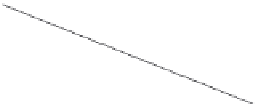Geoscience Reference
In-Depth Information
Fig. 10.24 Scaled outflow hydrograph
q
+
=
q
+
(
t
+
)from
a linearized hydraulic aquifer into an
adjoining open water body (heavy line) as
given by (10.126), and the first term in the
series expansion (thin straight line). Here the
outflow rate is scaled with the initial outflow
rate
q
=
BI
c
; this initial outflow rate results
from a steady input
I
c
prior to
t
+
=
0, as
described in Example 10.3.
1
q
+
0.1
0
0.1
0.2
0.3
t
+
The second term on the right yields zero; therefore, upon integration of the first term on the
right of (10.123) with (10.117), one can write
exp
−
(2
n
−
1)
2
exp
(2
n
−
1)
2
0
∞
8
BI
c
(2
n
−
1)
2
π
2
k
0
η
0
t
2
k
0
η
0
τ
4
n
e
B
2
π
q
=−
π
2
4
n
e
B
2
−∞
(10.124)
n
=
1
,
2
or, finally, after application of the limits of integration,
exp
−
(2
n
−
1)
2
∞
2
k
0
η
0
t
8
BI
c
(2
n
−
1)
2
π
q
=−
(10.125)
π
2
4
n
e
B
2
n
=
1
,
2
At
t
=
0, when the steady input ceases, this solution yields the initial condition (10.121),
as it should. A feature worth noting in (10.125) is that it converges much more quickly to
the first term in the series than (10.113), on which the unit response (10.117) is based. This
rapid disappearance of the higher-order terms in (10.125) is best illustrated by expressing
it in dimensionless form. By scaling the outflow rate with the initial flow rate, so that in the
present case
q
+
=
q
/
(
BI
c
), (10.125) becomes
exp
−
(2
n
−
1)
2
∞
2
t
+
8
(2
n
−
1)
2
π
q
+
=−
(10.126)
π
2
4
n
=
1
,
2
where
t
+
is as defined in (10.94). Equation (10.126) is illustrated in Figure 10.24, where it can
be seen that only the first term survives, when
t
+
>
.
08; this is in contrast with (10.112),
illustrated in Figure 10.23 where the same can be seen to occur only for
t
+
>
0
2. The
difference between these two cases stems from the different initial condition. For (10.112)
the aquifer is assumed to be initially fully saturated, whereas for (10.126), the water table
is initially assumed to be described by the linearized version of (10.35).
0
.
Example 10.4
Consider now the outflow resulting from rainfall as an arbitrary input function of time
I
=
P
(
t
). In principle there should be no problem in carrying out the convolution integration,







































